October is American Archives Month, which is an opportunity for archives to raise awareness about archives, showcase their holdings, and, basically, let people know what we as archivists do. We give tours of our department throughout the year to classes and other groups, in part because our collections, unlike those of most libraries, are stored in closed stacks which are are normally not accessible by the public. As a part of this year’s Archives Month, this post will include a brief explanation of what a Special Collections and University Archives is all about and a blog version of the Special Collections tour .
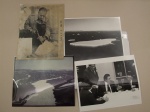
To start, what exactly is an archives or, for that matter, a Special Collections? A Special Collections, often within a library such as Parks Library here at ISU, contains rare and unique materials including rare books, publications, artifacts, films, and a variety of primary source materials. Primary materials can include diaries, correspondence, scrapbooks, and photographs. Pictured to the left are photographs from the International Conference and Workshops on Iceberg Utilization for Fresh Water Production, Weather Modification, and Other Applications Records (RS 0-4-4). A small selection of our photographs can be found on Flickr.
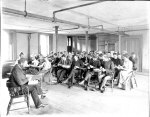
The difference between archives and manuscript collections can sometimes be a bit confusing, but the difference is not really necessary to know to get what you need here at Special Collections. Archives and manuscript collections are materials created and/or collected by a person or organization. For example, our University Archives contains the records of Iowa State University including faculty, students, alumni, and administrative offices which contain historical, administrative, legal, or fiscal value. An example of one of our University Archives collections are the Louis Hermann Pammel Papers. Pammel was a Professor of Botany here at ISU, and instrumental in the creation of Iowa’s state park system. Our manuscript collections are papers and records of people and organizations not necessarily associated with Iowa State but often related to the areas of agriculture, science and technology. An example of one of our manuscript collections would be the National Family Farm Coalition Records. To learn more about our mission and collecting areas, please visit our website.
If you love definitions of archives related words, or, as is more likely, come across a word we archivists use which is unfamiliar, please visit the wonderful Glossary of Archival and Records Terminology by Richard Pearce-Moses.
You probably noticed above that there are links to the finding aids of the Louis Hermann Pammel Papers and the National Family Farm Coalition Records. A finding aid is a structured description of a collection, and goes more in-depth than the catalog record you would find in the Library Catalog (a link to the catalog can be found on the library’s home page). Our finding aids generally contain a descriptive and administrative summary, historical or biographical note, collection description, and folder listing.
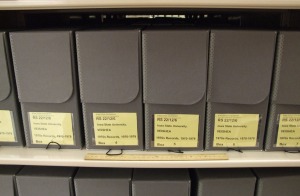 One important item to note in the administrative information found at the front of a finding aid is the extent, which will tell you how large a collection is (both the number of boxes and total linear feet of boxes). We primarily use three different sizes of boxes for the records (in addition to the oversize boxes, which are flat boxes in an assortment of sizes): records center, document and half document. Pictured above are the smaller of the two, the document boxes. Each document box is 0.42 feet in length. And just in case you were wondering, the half document boxes are half the size of the document box, or 0.21 linear feet.
One important item to note in the administrative information found at the front of a finding aid is the extent, which will tell you how large a collection is (both the number of boxes and total linear feet of boxes). We primarily use three different sizes of boxes for the records (in addition to the oversize boxes, which are flat boxes in an assortment of sizes): records center, document and half document. Pictured above are the smaller of the two, the document boxes. Each document box is 0.42 feet in length. And just in case you were wondering, the half document boxes are half the size of the document box, or 0.21 linear feet.
 The records center box is the larger box, and is about one foot wide by 1.3 feet long.
The records center box is the larger box, and is about one foot wide by 1.3 feet long.
 The collections in our university archives and manuscript collections are housed in acid-free folders and boxes, pictured above. When getting a collection ready for public use, often referred to as “processing,” archivists will rehouse, arrange, and describe the collection for storage and use by patrons. The folders contain the collection number (more or less equivalent to a book’s call number) and title at the upper left hand side. The folder title is in the middle, and the dates of the records housed within the folder are at the right hand side, along with the box and folder number.
The collections in our university archives and manuscript collections are housed in acid-free folders and boxes, pictured above. When getting a collection ready for public use, often referred to as “processing,” archivists will rehouse, arrange, and describe the collection for storage and use by patrons. The folders contain the collection number (more or less equivalent to a book’s call number) and title at the upper left hand side. The folder title is in the middle, and the dates of the records housed within the folder are at the right hand side, along with the box and folder number.
And now for the online tour of Iowa State University’s Special Collections and University Archives Department:
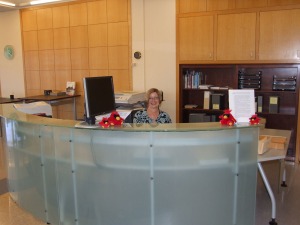 When you walk into our reading room, which is the area visitors will use to look at our rare books and collections, you will see our front desk and a friendly archivist ready to assist visitors. Once you have let us know what you need, we will have you fill out a registration form and put your coat and bags in our closet.
When you walk into our reading room, which is the area visitors will use to look at our rare books and collections, you will see our front desk and a friendly archivist ready to assist visitors. Once you have let us know what you need, we will have you fill out a registration form and put your coat and bags in our closet.
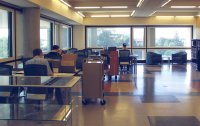 The material you request, whether it is a rare book or collection, will be pulled from the back and you will choose one of our desks in the reading room to do your research. No food or drink is allowed in the reading room, since many of the items are rare and unique and therefore hard to replace. In addition, pencils (not pens – which can leave a permanent mark!) need to be used. Pencils are provided at each of the desks.
The material you request, whether it is a rare book or collection, will be pulled from the back and you will choose one of our desks in the reading room to do your research. No food or drink is allowed in the reading room, since many of the items are rare and unique and therefore hard to replace. In addition, pencils (not pens – which can leave a permanent mark!) need to be used. Pencils are provided at each of the desks.
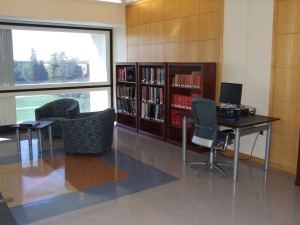 Most of our books, and all of our collections, are stored in the closed stacks which are not open to the public (unless you are on a tour led by one of our staff members). However, duplicates of some of our frequently used books about Iowa State are available in the reading room. These include directories, catalogs, the Bomb (Iowa State’s yearbook, published from 1894-1994), and books on the history of Iowa State including A Sesquicentennial History of Iowa State: Tradition and Transformation, The History of Iowa State College by Earle Dudley Ross, and VEISHEA the first sixty years. A public computer is also available for use.
Most of our books, and all of our collections, are stored in the closed stacks which are not open to the public (unless you are on a tour led by one of our staff members). However, duplicates of some of our frequently used books about Iowa State are available in the reading room. These include directories, catalogs, the Bomb (Iowa State’s yearbook, published from 1894-1994), and books on the history of Iowa State including A Sesquicentennial History of Iowa State: Tradition and Transformation, The History of Iowa State College by Earle Dudley Ross, and VEISHEA the first sixty years. A public computer is also available for use.
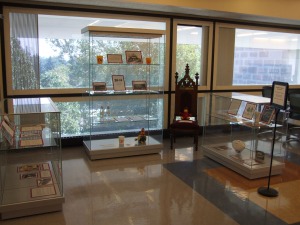 The reading room also contains small exhibits featuring ISU history and our collections. Our current exhibit is about ISU football: “Ev’ry Yard for ISU: Cyclone Football Through the Years.” To learn about our future exhibits, please visit our website.
The reading room also contains small exhibits featuring ISU history and our collections. Our current exhibit is about ISU football: “Ev’ry Yard for ISU: Cyclone Football Through the Years.” To learn about our future exhibits, please visit our website.
 The area beyond the reading room includes our processing area. Pictured here is the author of this post processing a collection.
The area beyond the reading room includes our processing area. Pictured here is the author of this post processing a collection.
 The collections are housed in a separately climate controlled area, with lower temperatures and relative humidity than the rest of the library. This is to better preserve the collections. Pictured above are the shelves you would first see when entering the collections area. These are just a portion of our new collections and additions to collections we already hold. When new materials come in, we generally re-box them and put them on these shelves, awaiting a time when we can process the collection.
The collections are housed in a separately climate controlled area, with lower temperatures and relative humidity than the rest of the library. This is to better preserve the collections. Pictured above are the shelves you would first see when entering the collections area. These are just a portion of our new collections and additions to collections we already hold. When new materials come in, we generally re-box them and put them on these shelves, awaiting a time when we can process the collection.
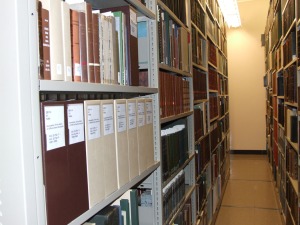 Our rare book collection contains over 50,000 volumes and includes (but not necessarily limited to!) books related to Iowa State University, agriculture, science, technology, Iowa, landscape architecture and the natural sciences (including entomology, botany, and ornithology.)
Our rare book collection contains over 50,000 volumes and includes (but not necessarily limited to!) books related to Iowa State University, agriculture, science, technology, Iowa, landscape architecture and the natural sciences (including entomology, botany, and ornithology.)
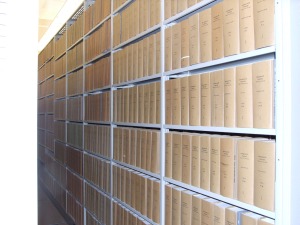 The rare books include theses and dissertations by Iowa State graduate students, shown above. As you can see, there are quite a few – and these are not all!
The rare books include theses and dissertations by Iowa State graduate students, shown above. As you can see, there are quite a few – and these are not all!
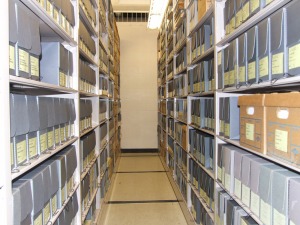 And above is one row of our collections. We have approximately 15,000 linear feet of university archives and manuscript collections.
And above is one row of our collections. We have approximately 15,000 linear feet of university archives and manuscript collections.
 Above is our university photograph collection. Some university photographs can be found within the collections (if this is the case, it is noted in the finding aid within the folder title), but many are separated into this collection for various reasons. Photographs include students, staff, faculty, alumni, university grounds and buildings, university departments, and other images related to university sites and activities.
Above is our university photograph collection. Some university photographs can be found within the collections (if this is the case, it is noted in the finding aid within the folder title), but many are separated into this collection for various reasons. Photographs include students, staff, faculty, alumni, university grounds and buildings, university departments, and other images related to university sites and activities.
 In addition to books and historical records, we also have audio and visual materials including over 10,000 films in our film collection, the majority of which were produced by, or are about, ISU. These films focus on the activities of Iowa State faculty, staff, students, and alumni. They cover the topics of agriculture, science, technology, home economics, and campus events. A selection of these films can be found on our YouTube channel. Some of our audio materials, including oral histories, can be found on the university’s iTunesU under Parks Library.
In addition to books and historical records, we also have audio and visual materials including over 10,000 films in our film collection, the majority of which were produced by, or are about, ISU. These films focus on the activities of Iowa State faculty, staff, students, and alumni. They cover the topics of agriculture, science, technology, home economics, and campus events. A selection of these films can be found on our YouTube channel. Some of our audio materials, including oral histories, can be found on the university’s iTunesU under Parks Library.
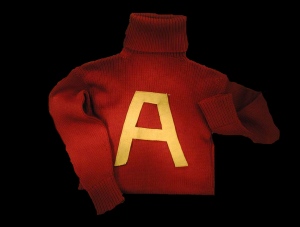 The department also collects a variety of artifacts. Currently, there are about 2,500 items in the artifact collection dating from 1849 to the present. Examples of these objects include the death mask of Margaret Stanton (preceptress and wife of Edgar Stanton, class of 1872), a letter sweater, freshman beanies, the National Medal of Technology given to John Vincent Atanasoff, and numerous buttons and pins from various campus organizations and events.
The department also collects a variety of artifacts. Currently, there are about 2,500 items in the artifact collection dating from 1849 to the present. Examples of these objects include the death mask of Margaret Stanton (preceptress and wife of Edgar Stanton, class of 1872), a letter sweater, freshman beanies, the National Medal of Technology given to John Vincent Atanasoff, and numerous buttons and pins from various campus organizations and events.
Although we’re in a separate area up here on the 4th floor of Parks Library, we often work with other areas of the library, including the Preservation Department. The preservation of our materials is very important, and a recent blog post by our preservation department discusses American Archives Month and the department’s importance to our mission.
And thus ends the online tour of Special Collections. Please visit our website to learn more!
